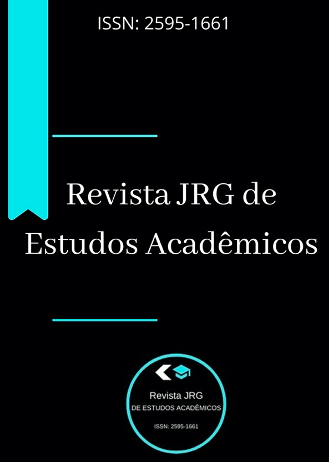EVOLUTION OF SARAMPOUS OUTBREAKS IN BRAZIL AND THE FIGHTING AND PREVENTION ACTIONS PRACTICED
DOI:
https://doi.org/10.5281/zenodo.3893027Keywords:
Measles. Epidemiological monitoring. PreventionAbstract
Objective: To analyze the evolution of the measles outbreak in Brazil in 2019, as well as the actions of combat and prevention practiced. Method: This is a literature review, the theoretical approach was elaborated from scientific publications extracted from the VHL database, which includes articles from other scientific databases, such as LILACS, SCIELO, PUB MED. We also used some documents published by the Ministry of Health, such as: Epidemiological Bulletins and Newsletters, Health Surveillance Guide and Ordinance. Results: In 2019, the peak of the disease in Brazil occurred between weeks 26 and 50 (23/06/2019 to 14/12/2019). Altogether, there were 18,203 confirmed cases, with 15 deaths. 526 municipalities distributed in 23 Federation Units confirmed cases of measles, most of them in the state of São Paulo, which concentrated 84% of the cases, followed by the states of Paraná (4.2%), Rio de Janeiro (1.8%), Pernambuco (1.5%), Santa Catarina (1.4%), Minas Gerais (0.7%) and Pará (0.6%), together adding a total of 17,955 cases or 98.6% of all cases in the country. Conclusion: The numerous outbreaks that spread throughout the various states caused concern of the health authorities, being carried out constant monitoring of the situation, adopting strategies aimed at eliminating the residue of susceptible in all age groups to allow the elimination of the disease in the country, again winning the certificate of country free of the disease. In the most affected states, however, none of them reached the vaccination target of 95% of the population in all its municipalities.
Objective: To analyze the evolution of the measles outbreak in Brazil in 2019, as well as the actions of combat and prevention practiced. Method: This is a literature review, the theoretical approach was elaborated from scientific publications extracted from the VHL database, which includes articles from other scientific databases, such as LILACS, SCIELO, PUB MED. We also used some documents published by the Ministry of Health, such as: Epidemiological Bulletins and Newsletters, Health Surveillance Guide and Ordinance. Results: In 2019, the peak of the disease in Brazil occurred between weeks 26 and 50 (23/06/2019 to 14/12/2019). Altogether, there were 18,203 confirmed cases, with 15 deaths. 526 municipalities distributed in 23 Federation Units confirmed cases of measles, most of them in the state of São Paulo, which concentrated 84% of the cases, followed by the states of Paraná (4.2%), Rio de Janeiro (1.8%), Pernambuco (1.5%), Santa Catarina (1.4%), Minas Gerais (0.7%) and Pará (0.6%), together adding a total of 17,955 cases or 98.6% of all cases in the country. Conclusion: The numerous outbreaks that spread throughout the various states caused concern of the health authorities, being carried out constant monitoring of the situation, adopting strategies aimed at eliminating the residue of susceptible in all age groups to allow the elimination of the disease in the country, again winning the certificate of country free of the disease. In the most affected states, however, none of them reached the vaccination target of 95% of the population in all its municipalities.
Downloads
References
Borges, AO, Paulo, AR, Araújo, GM, Costa, SQ. Surto de sarampo pelo baixo índice de vacinação no Brasil. Revista Saúde Multidisciplinar. 2019; Edição especial: 169-173.
Branco, VGC, Morgado, FEF. O surto de sarampo e a situação vacinal no Brasil. Revista de Medicina de Família e Saúde Mental. 2019; 1(1):74-88.
Rodrigues, SN, Diniz, SN. Análise de conteúdos de ensino-aprendizagem em materiais educativos: sarampo. 10º Seminário de Iniciação Científica. 1º Seminário de Pesquisa e Pós-Graduação Stricto Sensu. ago. 2019.
Carvalho, AL, Dorabela, A, Andrade, JG, Diniz, LMO, Romanelli, RMC. Sarampo: atualizações e reemergência. Rev Med Minas Gerais. 2019; 29(Supl 13):80-85.
Person, OC, Puga, MÊS, Atallah, ÁN. Riscos, benefícios e argumentos para vacinação contra o sarampo: uma síntese de evidências. Diagn Tratamento. 2019; 24(3): 102-105.
Reyes, NKS, Albuquerque, DS, Mendonça, TMO, Cordeiro, J, Dias, CM. Modelagem matemática para a vacinação contra o sarampo.Proceeding Series of the Brazilian Society of Computational and Applied Mathematics. 2020; 7(1):1-2.
Ferreira, RSB, Sousa, JRR, Santos, JLP, Silva, SM, Rosa, ACS, Costa, JPR, Matos, JC. Correlação entre cobertura vacinal e notificação por sarampo no Distrito Federal. Revista Eletrônica Acervo Saúde. 2019; 11(17): e1654:1-8.
Brasil. Ministério da Saúde. Guia de vigilância em saúde. 3ª edição. Brasília: MS; 2019.
Xavier, AR, Rodrigues, TS, Santos, LS, Lacerda, GS, Kanaan, S. Diagnóstico clínico laboratorial e profilático do sarampo no Brasil. J Bras Patol Med Lab. 2019; 55(4): 390-401.
Brasil. Ministério da Saúde. Boletim epidemiológico 25. Brasília: MS; set. 2019. 50(25):1-16.
Moura, ADA, Braga, AVL, Carneiro, AKB, Alves, ECS, Bastos, CMM, Nunes, IH, Figueiredo, TWS, Canto, SVE, Garcia, MHO, Teixeira, AMS. Monitoramento Rápido de Vacinação na prevenção do sarampo no estado do Ceará, em 2015. Epidemiol. Serv. Saude. 2018; 27(2):e2016380:1-8.
Pereira, JPC, Braga, GM, Costa, GA. Negligência à vacinação: o retorno do Sarampo ao Brasil. e-Scientia. 2019; 12(1):1-5.
Waldman, EA, Sato, APS. Trajetória das doenças infecciosas no Brasil nos últimos 50 anos: um contínuo desafio. Revista de Saúde Pública. 2016; 50(68): 1-18.
Brasil. Ministério da Saúde. Boletim epidemiológico 06. Brasília: MS; fev. 2020. 51(6):1-37.
Brasil. Secretaria de Saúde do Distrito Federal. Informe epidemiológico: semana epidemiológica 52. Brasília: GDF; 2020. 1-4.
Brasil. Ministério da Saúde. Portaria Nº 204, de 17 de fevereiro de 2016. Define a Lista Nacional de Notificação Compulsória de doenças, agravos e eventos de saúde pública nos serviços de saúde públicos e privados em todo o território nacional, nos termos do anexo, e dá outras providências. Diário Oficial da União Brasil, Brasília (DF), 2016.











































